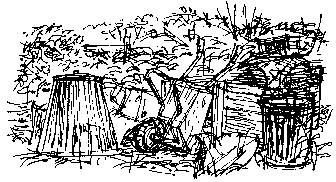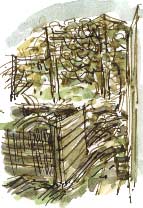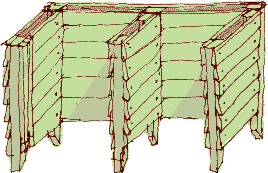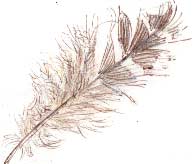 MY NEIGHBOUR DEREK had the summerhouse in his back garden demolished yesterday
and I asked him, if there was any decent timber that he was going to throw
in the skip, could I have it to reconstruct my compost bins.
MY NEIGHBOUR DEREK had the summerhouse in his back garden demolished yesterday
and I asked him, if there was any decent timber that he was going to throw
in the skip, could I have it to reconstruct my compost bins.Heap of Dreams |
Richard Bell's Wild West Yorkshire nature diary, Thursday, 2nd August, 2007 |
 MY NEIGHBOUR DEREK had the summerhouse in his back garden demolished yesterday
and I asked him, if there was any decent timber that he was going to throw
in the skip, could I have it to reconstruct my compost bins.
MY NEIGHBOUR DEREK had the summerhouse in his back garden demolished yesterday
and I asked him, if there was any decent timber that he was going to throw
in the skip, could I have it to reconstruct my compost bins.
 There’s
plenty of cladding and five lengths of 3 x 2 inch timber so, rather than patch
the
old bins, I can start again from scratch. With so much
timber available, I can go for a double wall, packed with cardboard cartons
in the cavity, to insulate the heap against excessive heat and cold. The cardboard
can go on the heap when it starts to decompose.
There’s
plenty of cladding and five lengths of 3 x 2 inch timber so, rather than patch
the
old bins, I can start again from scratch. With so much
timber available, I can go for a double wall, packed with cardboard cartons
in the cavity, to insulate the heap against excessive heat and cold. The cardboard
can go on the heap when it starts to decompose.
It’s a good idea to have some kind of lid on a compost bin; even a piece of old carpet will help insulate the heap and prevent it becoming too waterlogged. The compost should be as moist as a squeezed sponge so you might need to water it before putting the lid on.
At the moment I’ve got a lid of sorts. It’s a square top panel from a cold frame that I was given years ago, an aluminium-framed glass panel, but, even though its got a handle, it’s too cumbersome when you’re lifting it with one hand and emptying a trug of clippings with the other.
 I did consider planting a squash in some
soil on top of the heap and using the lid as a cold frame for it. In Grow
Your Own magazine I saw an advertisement
for a lightweight cold frame that fits on the top of a square compost bin.
I did consider planting a squash in some
soil on top of the heap and using the lid as a cold frame for it. In Grow
Your Own magazine I saw an advertisement
for a lightweight cold frame that fits on the top of a square compost bin.
 My
compost heap seems to be in constant use, so I don’t think this would
suit our garden. We noticed that in a mountainous region of Austria people
grew squashes on the top of compost or manure heaps. A way of extending the
season, making the most of the heat generated by the heap and providing a nutrient-rich,
water-retaining compost for the squash.
My
compost heap seems to be in constant use, so I don’t think this would
suit our garden. We noticed that in a mountainous region of Austria people
grew squashes on the top of compost or manure heaps. A way of extending the
season, making the most of the heat generated by the heap and providing a nutrient-rich,
water-retaining compost for the squash.
There’s only one place in the garden where I can fit in my double compost bin and that’s in a triangle between the back of the greenhouse and the hedge. Although I will have to work within this fixed footprint, I could make the bins a little taller than previously to accommodate the large amounts of compostable material that our garden and kitchen generate.
On the left side of my sketch (right), I've indicated the rails I'll nail on the front of the bin so that I can slot pieces of timber in at the front to retain the material as I build up the heap.
My last compost bin was made of pressure-treated timber and has lasted two decades but the pieces in direct contact with the soil have now decayed. I intend to give the recycled timber for the new heap a coat of Wickes Garden Colour (in 'herb garden' green), which shoud give it several years protection although I wouldn't expect it to last as long as the pressure-treated.
 It's
not just the kitchen that generates potential compost; as I was writing this
Barbara, who was sorting out the spare
bedroom, asked what are we going to do with our old feathers pillows
(we bought new recently).
It's
not just the kitchen that generates potential compost; as I was writing this
Barbara, who was sorting out the spare
bedroom, asked what are we going to do with our old feathers pillows
(we bought new recently).
Using Google, I soon found this quote at the Soil And Health Library:
Hair contains ten times the nitrogen of most manures. It resists absorbing moisture and readily compresses, mats, and sheds water, so hair needs to be mixed with other wetter materials. If I had easy access to a barber shop, beauty salon, or poodle grooming business, I'd definitely use hair in my compost. Feathers, feather meal and feather dust (a bird's equivalent to hair) have similar qualities.
Steve Solomon, Organic Gardener's Composting
We're going to empty the feathers, one pillow at a time, into a plastic sack
and every time we put soft, moist material such as grass clippings on the
compost heap I’ll
add a few handfuls. This will probably work better with our plastic compost
bins as there'll be no chance of the feathers blowing away.
Who knows we might
even find a use for the cotton pillow cases when we’ve
washed them. Potato sacks?